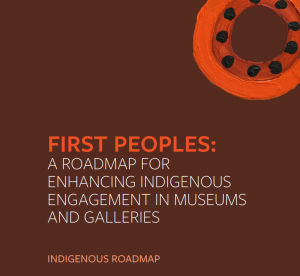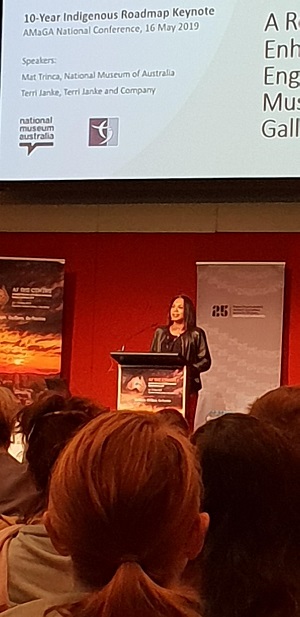
One hundred percent of Australian museums and galleries to have an Indigenous curator, senior leadership representation, policies for interpreting Indigenous materials and Reconciliation Action Plans are part of the ambitious targets for 2029 in a new industry roadmap for Indigenous engagement.
First peoples: A roadmap for enhancing Indigenous engagement in museums and galleries was commissioned by the Australian Museums and Galleries Association (AMaGA) and launched by its author, Indigenous intellectual copyright expert Terri Janke at last week’s AMaGA National Conference in Alice Springs.
The 40 page report is the result of extensive research with industry professionals, Indigenous stakeholders and museums and gallery visitors during the past two years. Museums & Galleries of NSW was a contributor through its Living Centres for Living Cultures 2 report, which Terri Janke & Co also co-authored.
Work towards achieving targets outlined in the Roadmap is intended to start immediately, with all museums and galleries being asked to begin implementing the Indigenous Roadmap in 2019. The roadmap will be circulated for further discussion and feedback before AMaGA is expected to develop an implementation plan.
“Museums and galleries have the power to shape out nation’s identity and the relationship with Indigenous people,” the report says in its conclusions. “Museums must change past practice of focusing on Indigenous cultural material as objects and shift focus to acknowledging the deep connections that Indigenous people have to museum collections as Australia’s First Peoples.
“Museums and galleries must acknowledge the Indigenous knowledge and cultural practices associated with these objects are a living heritage.
“The aim of the Roadmap is to get to a place where there is seamless recognition of Indigenous participation at all levels of museum and gallery practice, and that extends across the sector nationally.”

The report outlines critical pathways towards reform in alignment, transformation and acceleration, followed by realignment in 2029. The alignment phase will produce a statement of reflection, create Reconciliation Action Plans, run cultural competency workshops, update policies, implement Indigenous Cultural and Intellectual Copyright Protocols and identify all cultural material and create inventories for Indigenous communities.
The transformation phase will include championing Indigenous staff to leadership roles, continue increasing Indigenous employment and amplify truth telling exhibitions. Acceleration will include Indigenous led and designed projects, relationship agreements with Indigenous communities, repatriation of all ancestral remains, the establishment of a National Keeping Place and development partnerships with Aboriginal Keeping Places.
Other key transformations the report says that will indicate if we have reached our destination in 2029 will include: National Indigenous Staff Networks, National Indigenous Youth Curators Program, National Indigenous Elders network, Indigenous Tourism partnerships, internship programs in all museums and galleries, Indigenous people employed in all areas of museums with a national employment strategy and integration of Indigenous languages throughout museums and galleries.
Among other benefits the roadmap outlines in its aims will be improved levels of engagement of Indigenous communities in the cultural sector; helping to drive the revitalisation of some Indigenous communities and strengthen relationships between volunteer run smaller galleries and museums and their local areas as well as guide and inspire larger institutions. Audiences will benefit from richer and more authentic collections, education and there will be deeper emotional and intellectual engagement with art, history and continuing cultures with stronger museums, galleries and art centres with connections to local communities.
“The success of the Roadmap requires the entire sector to engage in the process of Alignment, Transformation, Acceleration and Realignment in order to strengthen Indigenous engagement and participation,” the report concludes.” By following the Roadmap – reimagining representation, embedding Indigenous values, increasing Indigenous opportunities, acknowledging two-way caretaking of cultural objects and connecting communities, Australia’s cultural institutions can work with First Peoples to set the vision for a knowledgeable, creative, artistic, vibrant and culturally rich Australia – which understands its past, but looks to a shared future.”
The Indigenous Roadmap can be accessed on the AMaGA website.
Steve Miller, Aboriginal Sector Programs Manager, Museums & Galleries of NSW



